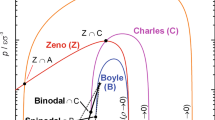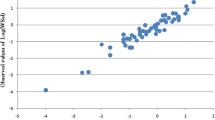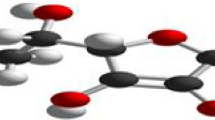Summary
Gas chromatographic data measured on mixtures of 19,24-dioctadecyldotetracontane, A≡C78, and 18,23-dioctadecyl-1-hentetracontanol, POH, allow the determination of the standard chemical potential of a solute on an ideal stationary phase with primary alcohol groups at ideal dilution. The Nearly Ideal Binary Solvent Theory provides the link between these data and the sociation constant of the solute with the primary alcohol. The method was applied to calculate sociation constants of a series of hydrogen bonding solutes. Results are compared with those determined by spectroscopy and calorimetry.
Similar content being viewed by others
References
R. Cloux, G. Défayes, K. Foti, J.-Cl. Dutoit, E. sz. Kováts, in preparation.
G.A. Huber, E.sz. Kováts, Anal. Chem.45, 1155 (1973).
J.H. Hildebrand, R.L. Scott, “The Solubility of Nonelectrolytes”, 3rd ed., Reinhold Publishing Corporation, New York, 1950.
K.S. Reddy, J.-Cl. Dutoit, E.sz. Kováts, J. Chromatogr., in press.
W.E. Acree, Jr., “Thermodynamic Properties of Nonelectrolyte Solutions”, Academic Press, London, 1984.
T.E. Burchfield, G.L. Bertrand, J. Solution Chem.4, 215 (1975).
W.E. Acree Jr., G.L. Bertrand, J. Solution Chem.12, 101 (1983).
E.A. Guggenheim, Trans. Faraday Soc.56, 1159 (1960).
R.L. Scott, J. Phys. Chem.75, 3843 (1971).
D.E. Martire, J. Phys. Chem.87, 2425 (1983).
W.A.P. Luck, W. Ditter, Ber. Bunsenges, Phys. Chem.72, 365 (1968).
I. Motoyama, C.H. Jarboe, J. Phys. Chem.71, 2723 (1967).
T. Gramstad, Spectrochim. Acta19, 497 (1963).
G.R. Wiley, S.I. Miller, J. Amer. Chem. Soc.94, 3287 (1972).
T.J.V. Findly, A.D. Kidman, Aust. J. Chem.18, 521 (1965).
E.D. Becker, Spectrochem. Acta17, 436 (1961).
D. Neernick, L. Lamberts, Bull. Soc. Chim. Belges75, 473 (1966).
E.M. Arnett, L. Joris, E. Mitchell, T.S.S.R. Murthy, T.M. Gorrie, P.R. Schleyer, J. Amer. Chem. Soc.92, 2365 (1970).
E.R. Kearns, J. Phys. Chem.65, 314 (1961).
Author information
Authors and Affiliations
Additional information
Dedicated to Professor Leslie S. Ettre on the occasion of his 70th birthday.
Rights and permissions
About this article
Cite this article
Reddy, K.S., Kováts, E.S. Pair-wise interactions by gas chromatography. Part II: Sociation free enthalpies of some hydrogen bonding solutes with non-associated primary alcohol groups. Chromatographia 34, 249–252 (1992). https://doi.org/10.1007/BF02268353
Received:
Accepted:
Issue Date:
DOI: https://doi.org/10.1007/BF02268353




